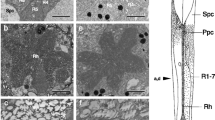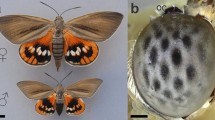Summary
In the compound eye of the moth Antheraea polyphemus, three types of visual pigments were found in extracts from the retina and by microspectrophotometry in situ. The absorption maxima of the receptor pigment P and the metarhodopsin M are at (1) P 520–530 nm, M 480–490 nm; (2) P 460–480 nm, M 530–540 nm; (3) P 330–340 nm, M 460–470 nm. Their localization was investigated by electron microscopy on eyes illuminated with different monochromatic lights. Within the tiered rhabdom, constituted of the rhabdomeres of nine visual cells, the basal cell contains a blue-and the six medial cells have a greenabsorbing pigment. The two distal cells of most ommatidia also have the blue pigment; only in the dorsal region of the eye, these cells contain a UV-absorbing pigment, which constitutes a portion of only ∼ 5% of the visual pigment content within the entire retina. The functional significance of this distribution is discussed.
Similar content being viewed by others
References
Autrum H, von Zwehl V (1964) Die spektrale Empfindlichkeit einzelner Sehzellen des Bienenauges. Z vergl Physiol 48:357–384
Bernard GD (1979) Red-absorbing visual pigment of butterflies. Science 203:1125–1127
Bernard GD, Owens ED, Voss Hurley A (1984) Intracellular optical physiology of the eye of the pyralid moth Amyelois. J Exp Zool 229:173–187
Ebrey TG, Honig B (1977) New wavelength-dependent visual pigment nomograms. Vision Res 17:147–151
Ephrussi B, Beadle GW (1936) A technique of transplantation for Drosophila. Am Nat 70:218–225
Hamann B, Langer H (1980) Sehfarbstoffe im Auge des Wasser-läufers Gerris lacustris L. Verh Dtsch Zool Ges, p 337
Höglund G, Hamdorf K, Langer H, Paulsen R, Schwemer J (1973) The photopigments in an insect retina. In: Langer H (ed) Biochemistry and physiology of visual pigments. Springer, Berlin Heidelberg New York, pp 167–174
Kretz R (1979) A behavioural analysis of colour vision in the ant Cataglyphis bicolor (Formicidae, Hymenoptera). J Comp Physiol 131:217–233
Langer H, Hamann B, Meinecke CC (1979) Tetrachromatic visual system in the moth Spodoptera exempta (Insecta: Noctuidae). J Comp Physiol 129:235–239
Langer H, Schlecht P, Schwemer J (1982) Microspectrophotometric investigation of insect visual pigments. In: Parker L (ed) Methods in enzymology, Vol 81, Academic Press, New York pp 729–741
Matič T (1983) Electrical inhibition in the retina of the butterfly Papilio. I. Four spectral types of photoreceptors. J Comp Physiol 152:169–182
Meinecke CC, Langer H (1984) Localization of visual pigments within rhabdoms of the compound eye of Spodoptera exempta (Insecta, Noctuidae). Cell Tissue Res 238:359–368
Meinertzhagen IA, Menzel R, Kahle G (1983) The identification of spectral receptor types in the retina and lamina of the dragonfly Sympetrum rubicundulum. J Comp Physiol 151:295–310
Schlecht P (1979) Colour discrimination in dim light: An analysis of the photoreceptor arrangement in the moth Deilephila. J Comp Physiol 129:257–267
Schlecht P, Hamdorf K, Langer H (1978) The arrangement of colour receptors in a fused rhabdom of an insect. J Comp Physiol 123:239–243
Schwemer J, Langer H (1982) Insect visual pigments. In: Parker L (ed) Methods in enzymology, Vol 81, Academic Press, New York, pp 182–207
Schwemer J, Paulsen R (1973) Three visual pigments in Deilephila elpenor (Lepidoptera, Sphingidae). J Comp Physiol 86:215–229
Schwind R, Schlecht P, Langer H (1984) Microspectrophotometric characterization and localization of three visual pigments in the compound eye of Notonecta glauca L. (Heteroptera). J Comp Physiol 154:341–346
Spurr AR (1969) A low-viscosity epoxy resin embedding medium for electron microscopy. J Ultrastruct Res 26:31–43
Struwe G (1972) Spectral sensitivity of single photoreceptors in the compound eye of a tropical butterfly (Helkonius numata). J Comp Physiol 79:197–201
Venable JH, Coggeshall R (1965) A simplified lead citrate stain for use in electron microscopy. J Cell Biol 25:407–408
Welsch B (1977) Ultrastruktur und funktionelle Morphologie der Augen des Nachtfalters Deilephila elpenor (Lepidoptera, Sphingidae). Cytobiologie 14:378–400
White RH, Brown PK, Hurley AK, Bennett RR (1983) Rhodopsins, retinula cell ultrastructure, and receptor potentials in the developing pupal eye of the moth Manduca sexta. J Comp Physiol 150:153–163
Author information
Authors and Affiliations
Rights and permissions
About this article
Cite this article
Langer, H., Schmeinck, G. & Anton-Erxleben, F. Identification and localization of visual pigments in the retina of the moth, Antheraea polyphemus (Insecta, Saturniidae). Cell Tissue Res. 245, 81–89 (1986). https://doi.org/10.1007/BF00218089
Accepted:
Issue Date:
DOI: https://doi.org/10.1007/BF00218089




